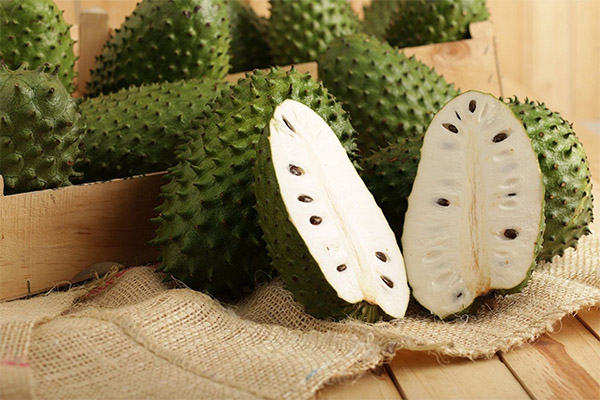Guanabana is one of the popular exotic plants with juicy and aromatic fruits. It is common in the wild, but it has been cultivated for more than a century in countries with a suitable climate. Guanabana fruits are of special culinary value – they are distinguished by their pronounced aroma and taste. But these are not all the benefits of the plant, because guanabana is a storehouse of valuable minerals, vitamins, and biologically active substances that can restore the body and help with various diseases. To use the healing power of guanabana fruits, you need to know their beneficial properties, contraindications, and features.

- Guanabana is a plant that is better known as sausep. Also, this plant is called “sour cream apple”. Guanabana is one of the most popular members of the Annona genus. The scientific name for this evergreen tree is Annona prickly. This plant is considered the largest-fruited among all members of the genus.
- Guanabana is of interest not only to gardeners who grow it. For more than a decade, pharmacists have been studying it, since the composition of fruits and leaves contains unique components that can affect the biochemistry in the body. Today, sausep is also of interest to geneticists – this prolific plant is studied by breeders, more productive, early ripening hybrids are regularly produced.
- The most valuable thing in this plant is the fruit. They are rich in minerals and vitamins, have a sweet and sour taste, and a bright fruit and berry aroma. The pulp is used to prepare desserts, cocktails, wine, non-alcoholic and alcoholic drinks. A significant disadvantage is that, due to a large amount of sugar, the fruits of guanabana spoil too quickly, so they are never transported in ripe form. The harvest is harvested before the fruits are ripe so that they do not have time to rot during transportation.
- Annona prickly is a tropical plant that is common on almost all continents. It grows in China, Sri Lanka is grown in Australia, India. The tree is quite thermophilic, and also cannot bear fruit when there is a shortage of sunlight, so it cannot be grown under artificial conditions.
- Guanabana is not the most dietary product. The pulp of this fruit contains a lot of various types of carbohydrates, so do not overuse it in the afternoon. 100 g of the product contains 94 kcal, but if the pulp is cooked, the calorie content of the product decreases from 94 kcal to 56 kcal per 100 g. 100 g of the product contains up to 10 g of carbohydrates (sucrose, fructose, polysaccharides). The pulp also contains fats and vegetable proteins – up to 1 g per 100 g.
- Also, the pulp of the fruit contains organic acids, as well as fats in small concentrations. They help accelerate metabolic processes in the body, cleanse blood vessels and the liver. With regular use, guanabana rejuvenates, strengthens the immune system, improves the condition of hair and skin, and also significantly increases the productivity of the brain.
- Even in ancient times, the indigenous people of the warm countries where guanabana was grown knew how useful its fruits were. Therefore, they actively used sour cream for medicinal purposes. But recent research into the composition of the fruit has also provided scientific evidence that sausep is indeed a therapeutically valuable product.
- The main area of use of guanabana is cooking. In Asian, Javanese, and Australian cuisine, desserts with this fruit are as popular as apple pies in our latitudes. The most common way to eat it is raw. This way the taste of these exotic fruits is fully preserved, and the concentration of valuable components is not lost.
- Raw guanabana is eaten not only in its pure form. It is used in many foods and drinks.
- In its raw form, guanabana has a tart-sweet and sour taste and a pronounced aroma. This must be taken into account when choosing products that will be combined with this fruit. But you can also cook many other delicious dishes with Annona fruits.
- It is almost impossible to buy ripe guanabana fruit in regions where it is not grown due to the unsuitable climate. Since in the process of transportation, literally in three days, ripe fruits begin to rot, they are brought to stores unripe. But this is not a problem, since in just a few days the skin of the fruit will turn yellow, after which you can fully enjoy its taste. Also, there are five rules to help you choose the most delicious and healthy fruits.
- You can store Annona fruits at room temperature or on the bottom shelf in the refrigerator. If you need to wait until the fruit is ripe, it is better to leave it on the windowsill. If you leave guanabana in the refrigerator, it will take a long time to ripen. The cut or peeled fruit should be consumed within a few hours since the pulp starts to deteriorate 2-3 times faster on contact with oxygen. If the flesh of the product has darkened or began to exude an unpleasant odor, it is not worth eating it – this indicates that the fermentation process has already begun.
- Guanabana has long been considered an ornamental plant, and few people took an interest in it. The thing is that in ancient times people did not know the cause of poisoning with this fruit, and only after a while the presence of toxins in the seeds of Annona was revealed. But these are not all interesting facts from the history of the plant.
- More recently, Annona began to grow in modern greenhouses, where it is possible to create conditions as close to natural as possible.
- Annona can be used as a houseplant. If you provide proper care, you can even get fruits three years after planting.
- Annona contains a complex of acids, which is used by manufacturers of expensive Israeli cosmetics for whitening creams and masks that can eliminate hyperpigmentation in several applications.
- As you can see, guanabana is an extremely healthy product, which also has an appetizing appearance, strong aroma, and pronounced taste. Knowing its healing properties and the basic rules of use, you can use the full potential of the fruit to strengthen health, restore the functioning of the body and fight various diseases.

